Development of a novel homogeneous immunoassay using the engineered luminescent enzyme NanoLuc for the quantification of the mycotoxin fumonisin B1
Author details:
Compared to the traditional heterogeneous assays, a homogeneous immunoassay is a preferred format for its simplicity. By cloning and isolating luminescent proteins from bioluminescent organisms, bioluminescence has been widely used for various biological applications. In this study, we present the development of a homogeneous luminescence immunoassay (FNanoBiT assay) for detection of fumonisin B1 (FB1), based on the binding of two subunits of an engineered luminescent protein (NanoLuc). For the detection of the mycotoxin FB1 in foods, the anti-fumonisin antibody was conjugated to the large subunit of NanoLuc (FLgBiT), and the FB1 was conjugated to the small subunit (FSmBiT). The conjugates were used for the detection of FB1 in a competitive immunoassay format without the need of a secondary antibody, or washing steps. The developed FNanoBiT assay revealed high specificity toward FB1 with no cross-reactivity with other mycotoxins, and it demonstrated acceptable recovery (higher than 94%) and relative standard deviation from spiked maize samples. Further, the assay was successfully applied for the detection of FB1 in naturally contaminated maize, with a dynamic range of 0.533–6.81 ng mL-1 and a detection limit of 0.079 ng mL-1. The results derived with FNanoBiT assay of all spiked samples showed a strong correlation to those obtained by the High-performance liquid chromatography method. Thus, the FNanoBiT based homogeneous immunoassay could be used as a rapid, and simple tool for the analysis of mycotoxin-contaminated foods.
Keywords: Fumonisin Biosensor FNanoBiT assay Luminescence FLgBiT FSmBiT.
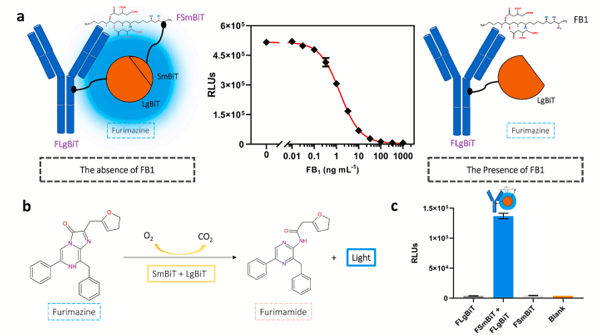
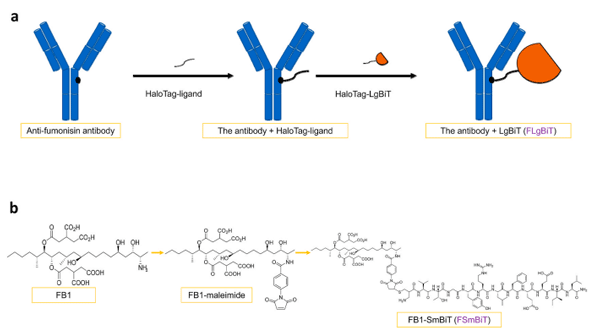
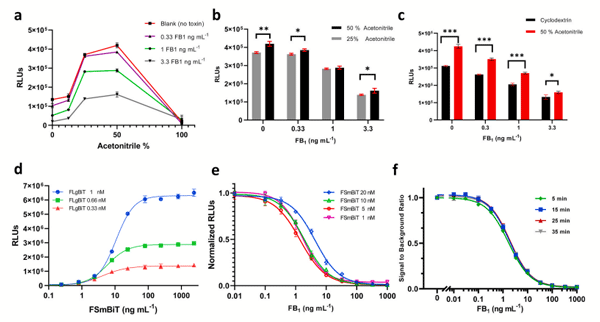
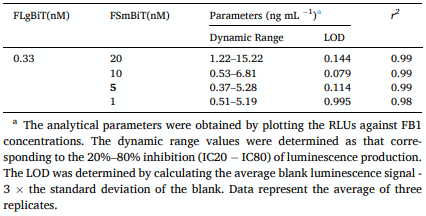
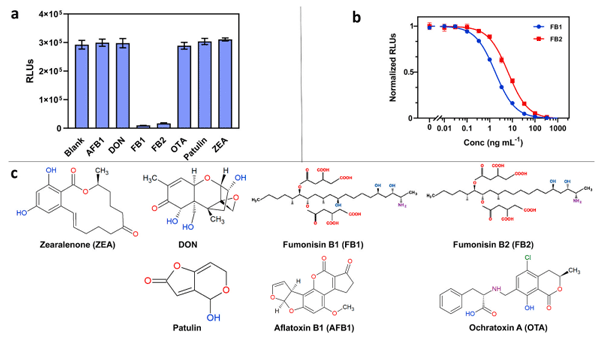
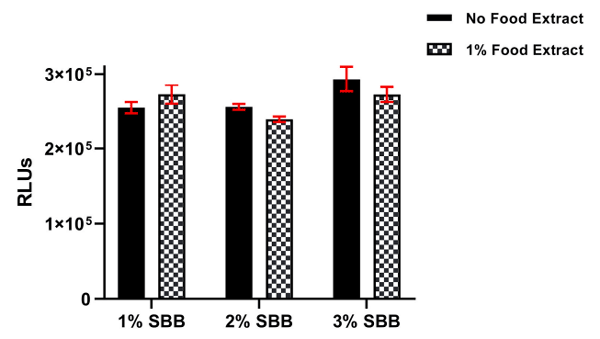
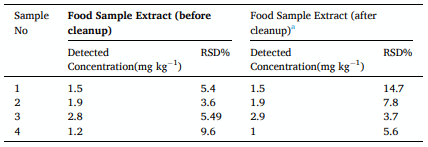



Azad, T., Tashakor, A., Hosseinkhani, S., 2014. Split-luciferase complementary assay: applications, recent developments, and future perspectives. Anal. Bioanal. Chem. 406, 5541–5560. https://doi.org/10.1007/s00216-014-7980-8.
Bian, Y., Huang, X., Ren, J., 2016. Sensitive and homogenous immunoassay of fumonisin in foods using single molecule fluorescence correlation spectroscopy. Anal. Methods 8, 1333–1338. https://doi.org/10.1039/c5ay02844b.
Chen, C., Riley, R.T., Wu, F., 2018. Dietary fumonisin and growth impairment in children and animals: a review. Compr. Rev. Food Sci. Food Saf. 17, 1448–1464. https://doi. org/10.1111/1541-4337.12392.
Chen, W., Yao, Y., Chen, T., Shen, W., Tang, S., Lee, H.K., 2021. Application of smartphone-based spectroscopy to biosample analysis: a review. Biosens. Bioelectron. 172, 112788. https://doi.org/10.1016/j.bios.2020.112788.
Dang, H.A., Varga-visi, E., ´ Zsolnai, A., T˘ a ´ ắt, T.O.M., ´ 2016. Analysis of fumonisins: a review. Vietnam J. Agric. Sci. 14, 1639–1649.
Darwish, I.A., 2006. Immunoassay methods and their applications in pharmaceutical analysis: basic methodology and recent advances. Int. J. Biomed. Sci. 2, 217–235.
De Baere, S., Croubels, S., Novak, B., Bichl, G., Antonissen, G., 2018. Development and validation of a UPLC-MS/MS and UPLC-HR-MS method for the determination of fumonisin B1 and its hydrolysed metabolites and fumonisin b2 in broiler chicken plasma. Toxins 10, 4–7. https://doi.org/10.3390/toxins10020062.
Dixon, A.S., Schwinn, M.K., Hall, M.P., Zimmerman, K., Otto, P., Lubben, T.H., Butler, B. L., Binkowski, B.F., Machleidt, T., Kirkland, T.A., Wood, M.G., Eggers, C.T., Encell, L. P., Wood, K.V., 2016. NanoLuc Complementation Reporter Optimized for Accurate Measurement of Protein Interactions in Cells. https://doi.org/10.1021/ acschembio.5b00753.
Elledge, S.K., Zhou, X.X., Byrnes, J.R., Martinko, A.J., Lui, I., Pance, K., Lim, S.A., Glasgow, J.E., Glasgow, A.A., Turcios, K., Iyer, N., Torres, L., Peluso, M.J., Henrich, T.J., Wang, T.T., Tato, C.M., Leung, K.K., Greenhouse, B., Wells, J.A., 2020. Engineering luminescent biosensors for point-of-care SARS-CoV-2 antibody detection. medRxiv Prepr. Serv. Heal. Sci. 1–34. https://doi.org/10.1101/ 2020.08.17.20176925.
Haddock, S.H.D., Moline, M.A., Case, J.F., 2010. Bioluminescence in the sea. Ann. Rev. Mar. Sci. 2, 443–493. https://doi.org/10.1146/annurev-marine-120308-081028.
Haeuser, C., Goldbach, P., Huwyler, J., Friess, W., Allmendinger, A., 2020. Excipients for room temperature stable freeze-dried monoclonal antibody formulations. J. Pharmacol. Sci. 109, 807–817. https://doi.org/10.1016/j.xphs.2019.10.016.
Hall, M.P., Unch, J., Binkowski, B.F., Valley, M.P., Butler, B.L., Wood, M.G., Otto, P., Zimmerman, K., Vidugiris, G., Machleidt, T., Robers, M.B., Benink, A., Eggers, C.T., Slater, M.R., Meisenheimer, P.L., Klaubert, D.H., Fan, F., Encell, L.P., Wood, K.V., 2012. Engineered Luciferase Reporter from a Deep Sea Shrimp Utilizing a Novel Imidazopyrazinone Substrate. https://doi.org/10.1021/cb3002478.
Huang, C.H., Park, Y. Il, Lin, H.Y., Pathania, D., Park, K.S., Avila-Wallace, M., Castro, C. M., Weissleder, R., Lee, H., 2019. Compact and filter-free luminescence biosensor for mobile in vitro diagnoses. ACS Nano 13, 11698–11706. https://doi.org/10.1021/ acsnano.9b05634.
Hwang, B., Engel, L., Goueli, S.A., Zegzouti, H., 2020. A homogeneous bioluminescent immunoassay to probe cellular signaling pathway regulation. Commun. Biol. 3, 1–12. https://doi.org/10.1038/s42003-019-0723-9.
International Agency for Research on Cancer, 2002. International agency for research on cancer iarc monographs on the evaluation of carcinogenic risks to humans. Iarc Monogr. Eval. Carcinog. Risks To Humansarc Monogr. Eval. Carcinog. Risks To Humans 96. https://doi.org/10.1002/food.19940380335 i-ix+1-390.
(JECFA) Joint FAO/WHO Expert Committee on Food Additives, 2017. Evaluation of Certain Contaminants in Food, Prepared by the Eighty-Third Report of the Joint FAO/WHO Expert Committee on Food Additives (JECFA), WHO Technical Report Series. https://doi.org/10.1126/science.1092089.
Kamle, M., Mahato, D.K., Devi, S., Lee, K.E., Kang, S.G., Kumar, P., 2019. Human health and their management strategies. Toxins 1–23. https://doi.org/10.3390/ toxins11060328.
Kim, H., Jung, Y., Doh, I.J., Lozano-Mahecha, R.A., Applegate, B., Bae, E., 2017. Smartphone-based low light detection for bioluminescence application. Sci. Rep. 7, 1–11. https://doi.org/10.1038/srep40203.
Lee, W. Il, Shrivastava, S., Duy, L.T., Yeong Kim, B., Son, Y.M., Lee, N.E., 2017. A smartphone imaging-based label-free and dual-wavelength fluorescent biosensor with high sensitivity and accuracy. Biosens. Bioelectron. 94, 643–650. https://doi. org/10.1016/j.bios.2017.03.061.
Li, C., Mi, T., Oliveri Conti, G., Yu, Q., Wen, K., Shen, J., Ferrante, M., Wang, Z., 2015. Development of a screening fluorescence polarization immunoassay for the simultaneous detection of fumonisins B1 and B2 in maize. J. Agric. Food Chem. 63, 4940–4946. https://doi.org/10.1021/acs.jafc.5b01845.
Li, C., Wen, K., Mi, T., Zhang, X., Zhang, H., Zhang, S., Shen, J., Wang, Z., 2016. A universal multi-wavelength fluorescence polarization immunoassay for multiplexed detection of mycotoxins in maize. Biosens. Bioelectron. 79, 258–265. https://doi.org/10.1016/j.bios.2015.12.033.
Los, G.V., Encell, L.P., McDougall, M.G., Hartzell, D.D., Karassina, N., Zimprich, C., Wood, M.G., Learish, R., Ohana, R.F., Urh, M., Simpson, D., Mendez, J., Zimmerman, K., Otto, P., Vidugiris, G., Zhu, J., Darzins, A., Klaubert, D.H., Bulleit, R. F., Wood, K.V., 2008. HaloTag: a novel protein labeling technology for cell imaging and protein analysis. ACS Chem. Biol. 3, 373–382. https://doi.org/10.1021/ cb800025k.
Lu, B., Iwuoha, E.I., Smyth, M.R., O’Kennedy, R., 1997. Effects of acetonitrile on horseradish peroxidase (HRP)-anti HRP antibody interaction. Biosens. Bioelectron. 12, 619–625. https://doi.org/10.1016/S0956-5663(97)00015-8.
Peltomaa, R., Amaro-Torres, F., Carrasco, S., Orellana, G., Benito-Pena, E., MorenoBondi, M.C., 2018. Homogeneous quenching immunoassay for fumonisin B1 based on gold nanoparticles and an epitope-mimicking yellow fluorescent protein. ACS Nano 12, 11333–11342. https://doi.org/10.1021/acsnano.8b06094.
Rateni, G., Dario, P., Cavallo, F., 2017. Smartphone-based food diagnostic technologies: a review. Sensors 17. https://doi.org/10.3390/s17061453.
Rottinghaus, G.E., Coatney, C.E., Minor, H.C., 1992. A rapid, sensitive thin layer chromatography procedure for the detection of fumonisin B1 and B2. J. Vet. Diagn. Invest. 4, 326–329. https://doi.org/10.1177/104063879200400316.
Shephard, G.S., Sydenham, E.W., Thiel, P.G., Gelderblom, W.C.A., 1990. Quantitative determination of fumonisins bi and b2 by high-performance liquid chromatography with fluorescence detection. J. Liq. Chromatogr. 13, 2077–2087. https://doi.org/ 10.1080/01483919008049014.
Silva, L., Fern´ andez-Franzon, ´ M., Font, G., Pena, A., Silveira, I., Lino, C., Manes, ˜ J., 2009. Analysis of fumonisins in corn-based food by liquid chromatography with fluorescence and mass spectrometry detectors. Food Chem. 112, 1031–1037. https://doi.org/10.1016/j.foodchem.2008.06.080.
Torelli, E., Firrao, G., Bianchi, G., Saccardo, F., Locci, R., 2012. European Commission Regulation No. 1126/2007 amending Regulation (EC) No 1881/2006 setting maximum levels for certain contaminants in foodstuffs as regards Fusarium toxins in maize and maize products. J. Sci. Food Agric. 92, 479–487. https://doi.org/ 10.1007/s11259-006-0018-8.
USFDA, 2001. Guidance for industry: fumonisin levels in human foods and animal feeds; final guidance. Prot. Promot. Your Heal. 4–7.
Visconti, A., Doko, M.B., Bottalico, C., Schurer, B., Boenke, A., 1994. Stability of fumonisins (Fb1 and fb2) in solution. Food Addit. Contam. 11, 427–431. https://doi. org/10.1080/02652039409374244.
Widder, E.A., Falls, B., 2014. Review of bioluminescence for engineers and scientists in biophotonics. IEEE J. Sel. Top. Quant. Electron. 20 https://doi.org/10.1109/ JSTQE.2013.2284434.
Xiao, Y., Isaacs, S.N., 2012. Enzyme-linked immunosorbent assay (ELISA) and blocking with bovine serum albumin (BSA)-not all BSAs are alike. J. Immunol. Methods 384, 148–151. https://doi.org/10.1016/j.jim.2012.06.009.
Zheng, M.Z., Richard, J.L., Binder, J., 2006. A review of rapid methods for the analysis of mycotoxins. Mycopathologia 161, 261–273. https://doi.org/10.1007/s11046-006- 0215-6.
Zhou, L., Zhang, L., Yang, L., Ni, W., Li, Y., Wu, Y., 2020. Tandem reassembly of split luciferase-DNA chimeras for bioluminescent detection of attomolar circulating microRNAs using a smartphone. Biosens. Bioelectron. 173, 112824. https://doi.org/ 10.1016/j.bios.2020.112824.







.jpg&w=3840&q=75)